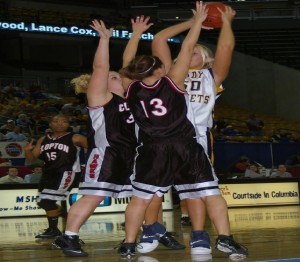5 Common Problems with a Full Court Trapping Defence

Taking advantage of the benefits of the well-executed Trapping Defence can be one of the finest moments a basketball coach can have. However, when things go wrong with a trapping defence it leads to a breakdown that often results in easy transition points such as lay-ups. This can be a very frustrating aspect of using a full court trapping defence, and one that if a coach does not know what to look for and can an ongoing problem that will lead to a team abandoning this tactic in lieu of standard man-to-man options. To help Functional Basketball Coaching has put together a list of the most common problems seen.
The single most common problem is players do not understand the trapping areas. It is sometimes overlooked by coaches that players just “get” how a full court trapping defence works. This is obviously not the case and nothing should be taken for granted. Even with senior players, every coach will have a slightly different way in which they would like a trapping defence to be constructed. For this reason with every new season and new team, comes the need to introduce the principles of the trapping defence to the players. This will ensure as a starting point that players will have a basic idea about how the trapping defence should unfold.
The second problem is poor foot and body position of the trapping players. The players involved in the trap often do not form a right angle and stop the player from being able to escape the trap. It is not uncommon for the two defending players involved in the trap to end up side by side, with both of their backs facing their defensive end of the floor, which allows the dribbler to perform a simple crossover, and move out of the pressure situation. There must be a player with the responsibility of stopping the dribbler from progressing down the floor while the second player in the trap must deny the ball being dribbled back to the middle of the court. Both players are responsible for not being split on their inside shoulder towards one another.
Another common problem is the next element of the two players involved in the trap not applying hand pressure. The trapping players because of the speed of the defence often forget to apply hand pressure to the dribbler. This means that once the ball is inevitably picked up, the pass can be made easily if not challenged by the defenders. The hand pressure of the defenders involved in the trap is a very important element in restricting the passing options available, buying time for off the ball defenders to cover the cutting offensive players and finally forcing a high and slow pass rather than a direct pass to an offensive teammate. For these reasons, the trapping defenders must be switched on to using their hands effectively.
Players not understanding how to exchange offensive players is another common problem facing trapping defences. Defenders off the ball will have to guard the offensive players who move into pressure release passing areas. The key is the defenders communicating while a player is in their area and moving into the next defenders area of responsibility. By calling the movement of the offensive player and letting the next defender know where the cutter is coming from will help a lot in this situation. However, communication is not the only part of the puzzle. The defenders must understand their areas of responsibility well so they do not rotate too far and create vast open spaces on the floor for other offensive players to rotate into. Additionally a coach must discuss scenarios where an exchange cannot happen and what the defender should do during these times. By practicing this situation it will have nothing but a positive effect on how good a team’s trapping defence can be.
One of the worst mistakes made by teams using a trapping defence is the inability to link multiple trapping situations into the same possession. Players both involved in the initial trap and off the ball must understand clearly all the rotation responsibilities they could be presented with. When using a full court trapping defence there are many times when secondary trapping situations can be triggered. To get the most out of the defence this tactic needs to be employed or the defence will not truly be as effective as it can be. It should also be noted that the second trap is often more effective then the first, as teams usually only have a press breaker to deal with the initial trap and not a secondary action.
A good full court trapping defence is a fantastic element to incorporate in to any team’s defensive playbook. Be on the lookout for ways in which to improve a trapping defence will have a dramatic effect in the number of situations this defence can be used and be useful.







